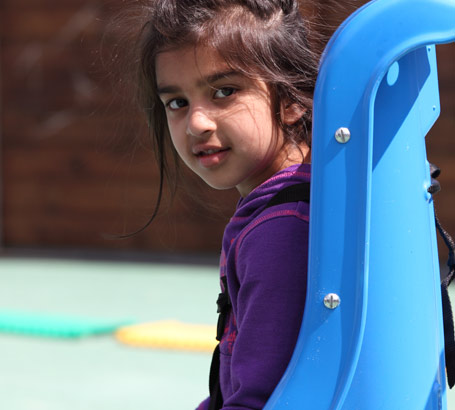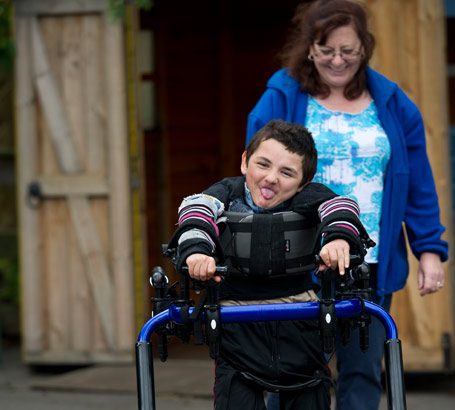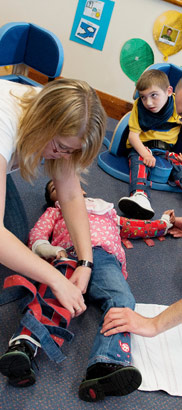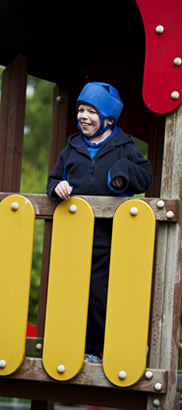
The web of support involves a constellation of professionals. Each professional produces guidance upon which other professionals
base decisions on intervention, care and support.
Consider which professionals are at the centre of the web and which are outliers. Some professionals may work directly with
the children and others contribute information less frequently and from a different venue. Their contact with individual children
may be infrequent but nevertheless is essential in planning intervention and care.
Consider where these professionals produce their contributions and how the information cascades to the centre of the web to
key workers. Where could difficulties arise in the transmission of information about children from specialist to key worker?
Issues such as these will be addressed as you work through this level.

Professional involvement with a child with CLDD could
initially be from either a medical or social level.
Medical problems might be visually apparent from birth. The first indications of complex learning difficulties and disabilities
can be evident before a child reaches school age.
Social impairments may be observed preschool. Conditions such as autism can become evident as a child deviates from expected
social developmental pathways. Occasionally problems become evident as a child starts school. Illness can complicate or compound
difficulties at any age.
Physical injury that leads to brain damage can affect development. Severe physical damage can cause motor problems preventing
learning and development.
Think of some children you know who have difficulties and write a list of when and where these problems were identified and
how confirmation was made. Were there social or medical symptoms or a combination?

Who do you think might instigate concerns if medical problems were not defined at birth? Make a list of people and places.
How might difficulties be identified?
Think about children you may have known who at first seemed to have no obvious problems but were eventually identified to
have significant special educational needs.

Often parents and family are the people who are concerned at first. Parents can very soon become expert in observations
and start searching for answers. The internet has opened up a means for the non-expert to learn from experts, however there
are problems involved with this line of inquiry.
What do you think the difficulties might be?
Case study: Jade
-
 Jade's mother 11:12
Jade's mother 11:12 -
 Jade's mother 21:02
Jade's mother 21:02
Jade was eventually diagnosed as having Foetal Alcohol Syndrome (FAS). Jade's adoptive mother was key to her diagnosis and provides a good example of how observation by parents can give evidence to the professionals to assist diagnoses. Listen to the audio clips of Jade's mother talking about her concerns about Jade in the early years and Jade's diagnosis of FAS and its implications.

Children may have evident health problems from birth which are identified by doctors in hospital or health workers visiting
homes. Referral to various services can be early as diagnoses are made of disabilities which manifest in physical differences
or anomalies. Some of the more evident symptoms of congenital differences such as Down Syndrome and spina bifida can be observed
from birth.
Other congenital problems such as heart defects can be discovered sometimes long after birth when indicative symptoms manifest
in inabilities of the child to reach expected milestones both physically and mentally.
Some problems such as Foetal Alcohol Syndrome may be acquired in the womb and others during birth. Premature delivery can
result in physical injury. Accidents can lead to acquired conditions such as head traumas or seriously broken limbs requiring
continuing orthopaedic assistance. Regular hospital assessments may follow.

The need for social expertise arises in clinics, play groups, home support and in review meetings. There is a near inexhaustible
list of experts used for referral whose roles we will be exploring.
Think of individual children and list the experts involved in their well-being and progress. How does the list for a typical
child compare with that of a child who has complex needs?

Sometimes medical conditions such as ADHD, not apparent at
birth, are revealed through social observations. Poor performance socially, in behaviour and in achievement, can trigger medical
investigation at preschool and school ages.
Whether the symptoms are of medical or social origin, it is now better recognised that a range of professionals from medical
and social backgrounds are required to work together. The systems of collaboration will be discussed later.
What starts as a medical problem can become a social problem and vice versa, so the support needs to work in both directions.
Consider the medical and social professionals needed by a child you know. Which came first?
Have you observed behaviours which have led to diagnoses of conditions? What are the most common indicators you have observed
and followed up? How did you share your concerns?

How do you see medical and social professionals working together? Consider whether this has always been the case.
Over recent years the SEN Code of Practice (2001) has encouraged multidisciplinary
working. This is where professionals of different disciplines contribute to a matrix of information on individual children.
How do you think the information is synthesised to benefit the child?
Transdiciplinary working involves synthesising information through working together. This will be discussed in more depth
in level D.
What are the advantages of sharing information? What drawbacks might this system have?

Early identification and diagnoses are key to securing effective intervention. Evidence-based inquiry shows the benefits
of early identification and intervention. Medical intervention gives the child the best opportunities to be mobile and cope
with their conditions.
The following Health Observatory report provides a comprehensive overview of the health needs experienced by people with learning
disabilities.
Emerson E. and Baines S. (2010) Health Inequalities & People with Learning Disabilities in the UK: 2010. Bristol: Health Observatory.
- Critically reflect on the children and young people that you are involved with.
- Develop a mind map of each class and the range of health needs experienced by the children.
- Identify the implications of the health needs on the school and the education workforce.

Each profession communicates their expertise to non-experts in their field, eg head teachers, heads of department and therapists.
To be effective, this communication must take account of the level of understanding of the recipient. It is important for
expert opinion to be passed effectively to the key workers who can optimise plans for learning opportunities.
Many professional aspects of sharing information amongst peers takes on a pattern which can be recognised by other professions.
Translating this to non-experts is one of the communications skills required for teamwork.
Think about your current communication with colleagues. Consider how you give and take information. Are there times when it
is better than others? What variations may occur and why? Cast a critical eye over your present personal communication systems.
Could you benefit from greater awareness of how you communicate?